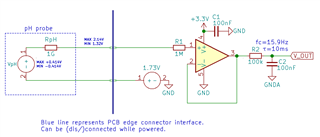Other Parts Discussed in Thread: LMP7721
Hi E2E,
Our customer would like to use the op-amp in a buffer configuration to condition the output of a high impedance source. They required the probe to be hot-swappable, where the non-inverting input can be disconnected while the op-amp is running. Are there any specific actions to be considered? Since the device does not have a shutdown pin, can they use a MOSFET to the power of OPA391 every time it is not in use to prevent the non-inverted input to be floating?
Regards,
Carlo





